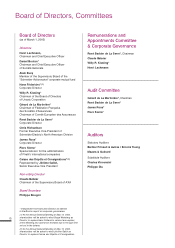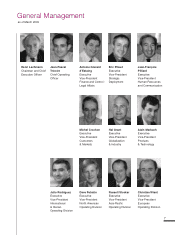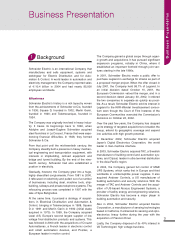APC 2004 Annual Report Download - page 16
Download and view the complete annual report
Please find page 16 of the 2004 APC annual report below. You can navigate through the pages in the report by either clicking on the pages listed below, or by using the keyword search tool below to find specific information within the annual report.
14
Increasingly, Schneider Electric is concentrating on
developing and patenting products that can be mar-
keted worldwide. Merlin Gerin-brand low voltage cir-
cuit breakers and Telemecanique-brand contactors,
for example, are sold in virtually all our principal mar-
kets. Like the Company's other international products,
they enjoy leadership positions based on reliability
and technological excellence. With this strategy of
globalization, we can penetrate a maximum number
of markets while optimizing costs.
At 5.2% of sales, Schneider Electric's R&D budget is
among the highest in the industry. It covers 4,500
employees around the world and development cen-
ters in 25 countries. This ongoing commitment has
allowed us to accelerate time to market and leverage
the technology of strategic partners with whom we
have also forged alliances to expand our lineup or
geographic coverage.
Lastly, the 50-million Schneider Electric Ventures
fund invests in start-ups whose technologies will form
the core of the Company's future lineup.
Global and local production facilities
Around one-third of Schneider Electric's production
sites are dedicated to global production. The others
are generally located as close as possible to their end
markets. Decisions on where to locate local and glob-
al plants are based on market proximity, competitive-
ness and skills developed over the years. At present,
the Company has 197 production facilities.
Although most of our products are built from stan-
dardized components so that they can be sold around
the world, they are also adapted to local standards
and requirements. Design and esthetics are some-
times adapted to local needs, but we focus heavily on
standardizing key components to achieve scale
economies in production. Certain physical features
will vary from region to region. This global/local
approach helps us optimize profitability.
In the last two years, the Company has deployed
plans in France, Germany, the UK and Italy to right-
size its manufacturing resources. This has involved
reducing the number of sites and redefining their mis-
sion. At the same time, we have increased production
capacity in Hungary, Poland, the Czech Republic,
Bulgaria, China and Mexico.
International standards
While we do tailor our products and equipment to
local standards, the majority of our lineup complies
with world-recognized International Electrotechnical
Commission (IEC) standards. In North America, our
products generally meet standards set by the National
Electrical Manufacturers Association (NEMA),
Underwriters Laboratory (UL) or American National
Standards Institute (ANSI). Since our products com-
ply with the dominant standards in our host markets,
we are able to meet most all of our customers' needs.
International purchasing and sourcing
We use raw materials such as silver, copper, steel,
non-ferrous metals and plastics, as well as electronic
components to manufacture our products. We source
from a diversified base of suppliers, selected for their
know-how, their products' quality and competitiveness
and their compliance with environmental and social
responsibility requirements.
We have supported the United Nations' Global
Compact since 2002 and encouraged our suppliers to
join as well. At the end of 2003, we signed a charter
based on the Global Compact's principles with sup-
pliers. To put its principles into action, the Global
Compact focuses on sharing experience during annu-
al meetings, identifying areas for improvement and
raising awareness by reminding all of us that its val-
ues are universal.
Schneider Electric's supplier list includes internation-
al companies such as Nippon Steel, DSM and Arcelor,
as well as medium-sized firms like Gindre Duchavany
or AMI Doduco.
Skills development
The diversity of Schneider Electric's geographic cov-
erage, markets and customer base is reflected in its
workforce, with a wide range of nationalities, skills,
ages and career profiles. This diversity is a key
strength. It fits in with the Company's assertive com-
mitment to getting the most synergy possible out of its
differences by fostering geographic and professional
mobility, skills transfers and exchanges, which are a
source of innovation. In this way, we are preparing the
future with multicultural teams.
Developing local human resources is another impor-
tant priority. The change in the number of expatriates
demonstrates our commitment to promoting local tal-
ent. This entails hiring locally, training, bringing people
up through the ranks and actively encouraging inter-
country mobility. This policy helps the Company
attract, lock-in and develop the best people in all of its
host countries.
New information and communication technologies
play a crucial role in team development. E-learning
modules are available for office automation, technical
training and marketing. In addition, more than 45,000
team members have access to the Company's vari-
ous intranet sites.
























